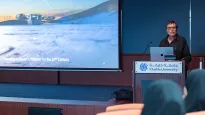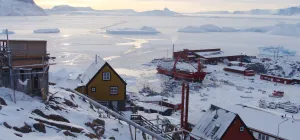Five Years of Princess Elisabeth Antarctica

This week, the International Polar Foundation celebreates five years of endevour and success since Princess Elisabeth Antarctica was inaugurated on February 15, 2009. However, the journey from the station's concept to its physical reality was a long and challenging adventure - one that we would like to share with you.
The Vision
Alain Hubert, an experienced polar explorer and engineer, and the International Polar Foundation, the non-profit organisation he established in 2002 along with glaciologist Hugo Declier (Vrij Universiteit Brussel) and climatologist André Berger (KU Leuven), set out to build the world’s first “zero emission” research station, designed to run entirely on renewable wind and solar energy.
Their first challenge was to convince sponsors to come on board. The International Polar Foundation succeeded in establishing a public/private partnership, and persuading businesses, the public sector, and civil society to take part in the project. In February 2004, the Belgian Federal Government commissioned the International Polar Foundation to take care of developing the station from design to completion. The station was to be named after Belgium’s young Princess Elisabeth, daughter of His Royal Highness King Philippe of Belgium.
Finding the Perfect Location
With a clear vision of the mission ahead, a team led by the International Polar Foundation headed to Antarctica in November 2004 on the first Belgian Antarctic Research Expedition (BELARE) to search for a suitable place to build the new station.
The station had to be built on solid rock, as the ice sheet covering most of Antarctica flows constantly towards the coasts. The ideal location had to be close to an ample supply of snow for drinking water, yet not be vulnerable to burial from too much snow accumulation - an unfortunate fate of previous Belgian stations. It also needed to be located at a place that facilitated logistical operations.
A ridge at Utsteinen in the western part of the Sør Rondane Mountains met all these requirements. The location allows safe access to the coast and is situated on the leeward side of the mountains, giving the ridge protection from storms. Steady katabatic winds from the interior of the continent not only make it an ideal place to use wind power, but they also prevent too much snow accumulation on the roof of the station.
Great Expectations
Designing a “zero emission” research station in Antarctica was no easy task, given there were no models to follow. Trial and error is not an option in a part of the world where it is only possible to do serious construction during the short summer between November and March, when 24-hour daylight prevails in the austral summer. Failing to meet a season’s construction targets not only means losing a full year, but also the confidence of sponsors.
Hanging in the Balance
Three expeditions to Antarctica were carried out from November 2004 to February 2007 to prepare Utsteinen Ridge for the Princess Elisabeth Antarctica’s construction. The end of the final preparatory season saw a critical moment for the project, in which the Princess Elisabeth Antarctica project was either going to sink or swim - literally.
At the end of the season, snow tractors and equipment were scheduled to be unloaded from a supply ship at the coast and transported to the construction site 220 km inland. As the first container was unloaded form the ship onto the ice shelf, cracks formed around the container and a piece of the ice shelf broke free, still holding the container. But thanks to quick thinking, the captain of the ship pushed the piece of the ice shelf back towards the coast, and Alain and the team managed to pull the container containing €1.5 million worth of equipment off of the collapsing ice shelf just in time.
“If the container and the tractor sunk into the ocean, the project would have been over. The entire project would have been lost in the water, literally.”
- Alain Hubert, President, International Polar Foundation
Giving the Public a Taste of Antarctica
Before being shipped to Antarctica, the main structure of the station was pre-constructed in Belgium. During the summer of 2007, construction teams completed this task at the Tour & Taxis exposition centre in Brussels. The pre-construction was a much-needed trial run for the builders who would reassemble the station under much more difficult conditions in Antarctica.
International Polar Foundation President Alain Hubert and His Royal Highness Prince Philippe – now King – of Belgium, opened the pre-constructed station to the general public. More than 35,000 visitors came to see the station over four days, September 6 - 9, 2007.
“When we saw the number of people coming to see the station in Tour & Taxis, we realised how popular that project had become, not only for us but also for Belgium and its citizens.”
- Johan Berte, Head Engineer, Princess Elisabeth Antarctica project
Construction Begins
Princess Elisabeth Antarctica was shipped to Antarctica during the autumn of 2007, and construction at Utsteinen began during the 2007-08 expedition. A large team braved tough Antarctic conditions to set up the main structure of the station. For several months, the team worked day and night, battling the bitter cold at times, to complete the task on time. On February 14 2008, the team secured the final module of the station’s main structure.
After the station successfully withstood its first eight months of the punishing Antarctic winter, the construction team returned in November 2008 to install the station’s water treatment system, electronics, more wind turbines, and the first field of solar panels. While construction was still taking place, the base already hosted its first scientific research teams starting in November 2008.
On February 15, 2009, Belgian Government ministers and officials, project sponsors and politicians made their way to the Princess Elisabeth Antarctica to celebrate the station’s official inauguration. Days before the first guests arrived for the celebration, the whole team redoubled their efforts to make sure all the finishing touches were in place.
Shifting to Full-Time Operations
Despite facing a number of challenges each season, each time the BELARE team has returned to Antarctica, the station has seen improvements. A satellite dish, which allows the station and its systems to be controlled remotely, was installed in 2010.
More importantly for the station’s concept, engineers set up a smart electrical grid, which manages the use of energy generated by wind turbines and solar panels. A priority-based central computer system determines how energy is allocated in the station. Intelligent energy management in the most extreme environment on the planet is the hallmark of the Princess Elisabeth Antarctica.
As the appointed Belgian Antarctic Operator, the International Polar Foundation ensures safe conditions for field research by providing experienced polar guides, handling cargo and personnel logistics, and providing accommodation and mobile laboratory facilities for scientists working in the field.
In in addition to a large number of Belgian scientists who have been to the staiton to conduct research since the station first welcomed scientists in 2008, the Princess Elisabeth Antarctica has also welcomed scientists from Japan, Germany, the US, the UK, Luxembourg and the Czech Republic. Scientists conduct reesarch in a wide variety of fields, including glaciology, microbiology, geology, geomagnetism, and atmospheric sciences. The Antarctic Plateau, subglacial lakes, dry valleys and ice shelves in the vicinity of the station provide a variety of research possibilities for scientists.
Members of the International Polar Foundation have witnessed some of the most fascinating research:
“While on a field expedition with a group of German geologists, we assisted them as they took rock samples from a site where the African and Antarctic continental plates collided some 500 million years ago, when the Gondwana supercontinent was forming. Seeing the deformed and folded rock where two ancient landmasses collided with my own eyes was a remarkable moment to me.”
- Nighat Amin, Vice-President, International Polar Foundation
In addition to providing logistical support to scientists, every two years since 2008, the InBev-Baillet Latour Fund and the International Polar Foundation award a €150,000 research grant, the InBev-Baillet Latour Antarctica Fellowship, to an early career polar scientist to fund a research project to be carried out at or near the Princess Elisabeth Antarctica. The goal is to help young polar scientists in their career while promoting excellence in polar research.
Looking Ahead
As a scientific research station, the goal of the Princess Elisabeth Antarctica is to make sure that as many scientists as possible can take advantage of its facilities and the professional support the station team offers. In order to ensure the long-term success of the station, the next goal is to find ways to cooperate with other countries in order to share the costs of operating the world’s first “zero emission” research station, while continuing to develop this exemplary prototype of sustainable living. The International Polar Foundation believes that Belgium can lead the way towards a low carbon future.
In developing the “zero emission” side of the Princess Elisabeth Antarctica project, we have proven that if we can live more sustainably in Antarctica, we can live more sustainably anywhere on the planet.
Download“The necessary know-how and technologies actually exist; all we need is more confidence that we can confront the future using the tools and experience at hand.”
- Alain Hubert, President, International Polar Foundation






















